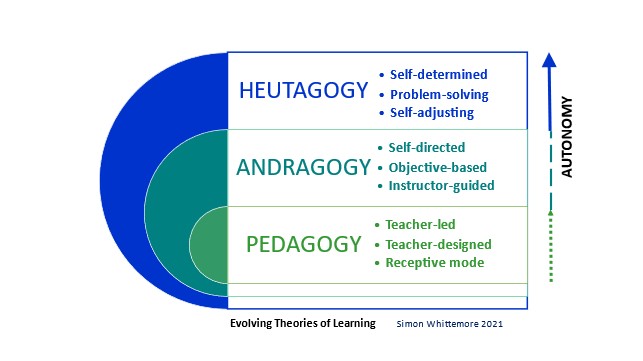Theories of Online Learning
We are at a critical point in history where we have access to a glut of information that is paradoxically littered with misinformation. Educating in this vast informational landscape requires precision and implementation based on solid, research-backed intention. Creating courses online is a multidisciplinary venture incorporating elements of psychology, graphic design, and technology. Current online pedagogy is built on a foundation that can be bifurcated into pre-internet and post-internet theories.
"Theories force us to look deeply at big-picture issues and grapple with the reasons why our technology use is likely to enhance teaching and learning."
Anderson, 2010, p. 23
Pre-Internet Learning Theories
Before the internet, there were correspondence courses. Information was transmitted through radio, textbooks, television, and mailed-in tests. During that time, Moore established the Theory of Transactional Distance, where he attempted to define the elements of distance learning. He split distance education into three components: student, teacher, and content. The interactions and quality of each relationship affected the overall learning experience and knowledge transmission.
Feedback and tests were not immediately accessible, so students could become lost, repeating and habituating the wrong skills. The quality of content and the incorporation of self-assessment became essential considerations. These ideas were further explored in the following theories: presentational view, performative tutoring, and epistemic engagement.

- Presentational View: Highlights the effective practice of using infographics, text, fonts, and design to decrease cognitive load and increase learning retention.
- Performative Tutoring: Assesses learners’ skills, identifies gaps in their knowledge and provides feedback and reinforcement practices influenced by behavioral psychology.
- Epistemic Engagement: Rooted in constructivism, this theory supports the idea that people construct their knowledge through personal history, experiences, and interactions with others. “Constructivist learning activities often focus on problems and require active inquiry techniques. These problems often work best when they are ill-structured, open-ended, and messy, forcing learners to go beyond formulaic solutions” (Anderson, 2010, p. 28). This promotes personal, real-world learning experiences and fosters active learning, leading to a richer educational experience.
Complexity Theory
This theory considers the holistic nature of real-life experiences and how one autonomous organism can affect an entire environment. True learning and development happen most efficiently at the “edge of chaos,” where students are emotionally and actively engaged, fostering deeper knowledge. For instance, learning on the job in real-world scenarios: when I trained to be a bartender, during my first few weeks, I shadowed an experienced employee. Encountering the myriad of customer problems during a shift forced me to think on my feet, adapt, and realize that not all problems have one solution and that there are multiple right answers.
"...the 'edge of chaos' where systems exhibit wild bursts of creativity and produce new and novel behaviors at the level of the whole system... complex systems innovate by producing spontaneous, systematic bouts of novelty out of which new patterns of behavior emerge."
Anderson, 2010, p. 28
Post-Internet Learning Theories

The Pedagogy of Nearness
This theory encourages instructors to be mindful of the barriers between screen-based learning and real-life interaction and explore the commonalities and how they relate to each other. Instructors encourage the “capacity of learning to flow seamlessly between online and face-to-face contexts” (Anderson, 2010, p. 32). Examples include flipped classrooms, where the students are meant to digest the information at home, and then when they get to IRL class, they can discuss and ask any questions about the content with their peers and teacher.

Heutagogy

Teaching students how to teach themselves is a critical life skill in this rapidly changing environment. In this approach, the teacher becomes a guide or digital sherpa, showing students how to traverse the informational landscape and forage for the right answers. Knowledge acquisition becomes self-motivated and relevant to real-world issues, connecting students’ education to their daily lives and problem-solving needs.
Connectivism
This theory emphasizes the importance of linking learners to vast networks of information. With so many people creating content, staying at the forefront of advancements is crucial. This is achieved by connecting to nodes (learning resources, machines that store and generate information and people) and expanding beyond the classrom to different perspectives and knowledge through globally digital community learning. “Being able to see, navigate, and create connections between nodes becomes the goal of connectivist learning” (Anderson, 2010, p. 34). While it vastly increases resources and information, it also amplifies the risk of misinformation, underscoring the importance of heutagogy in helping learners critically evaluate information.

Conclusion
Instructional pedagogy is heavily influenced by advancements in technology. Instructors risk overusing trendy technologies at the expense of learner comprehension and retention. To create the most effective, science-backed learning experience possible, instructors must explore and synthesize the best components of past and present research, avoiding the temptation to sacrifice effectiveness for hype or buzzwords.
"Like Net culture itself, these theories borrow from and expand pre-net ideas while envisioning new ways that knowledge is created, shared, and adapted."
Anderson, 2010, p. 37